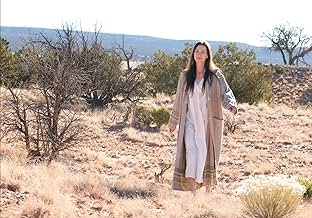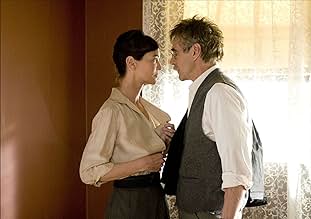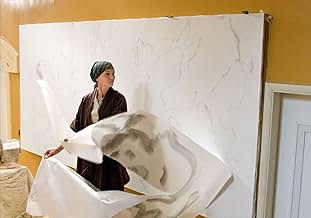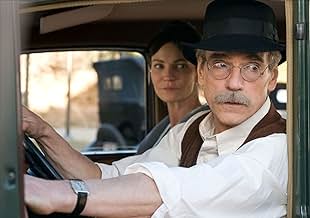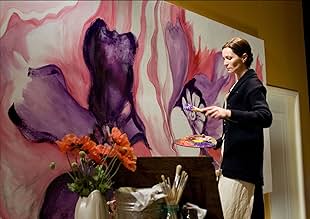Füge eine Handlung in deiner Sprache hinzuBiopic of American artist Georgia O'Keeffe and her husband, photographer Alfred Stieglitz.Biopic of American artist Georgia O'Keeffe and her husband, photographer Alfred Stieglitz.Biopic of American artist Georgia O'Keeffe and her husband, photographer Alfred Stieglitz.
- Für 9 Primetime Emmys nominiert
- 1 Gewinn & 28 Nominierungen insgesamt
Empfohlene Bewertungen
a correct story. who could be better. but, in strange manner, it is only a detail. because it is a classic biopic, using the right recipes, giving Joan Allen and Jeremy Irons in decent roles, suggesting the universe and the crisis and the fight of a great artist. and nothing more. and this does the viewer to be the only obvious judge. because it is his verdict. a good introduction to the art of a painter . or disappointed portrait of her. for me, the truth is between this view points. maybe, because it seems be not easy to present the essence and the roots and the shadows of an art who remains so fresh question about yourself. and the sketch of social relations or about the need to create is enough for suggest the right way to discover her world.
I have followed Stieglitz for 40 years via catalogs, books, videos, and exhibitions. I branched out to adore O'Keefe for her work, and, increasingly for her individuality and spunk.
This portrayal of the woman fills a much needed gap in her biography and that of Alfred. The harmonies played by the character weave a phenomenal presentation of these lives.
For anyone who has read biographies, autobiographies, or other papers on these two lives will easily fill the gaps in this abbreviated portrayal. If I get the chance this program will become a part of my own collection of these artists lives - It's a keeper.
This portrayal of the woman fills a much needed gap in her biography and that of Alfred. The harmonies played by the character weave a phenomenal presentation of these lives.
For anyone who has read biographies, autobiographies, or other papers on these two lives will easily fill the gaps in this abbreviated portrayal. If I get the chance this program will become a part of my own collection of these artists lives - It's a keeper.
I like the basic story; however, I really was disappointed in the director, the DP, and the Gaffer (the person who lights the scenes). The story clearly demonstrated the tumultuous relationship she had with her husband, and control freak, Alfred Steiglitz. That dynamic is very important in explaining who O'Keeffe was. However, I did not like the technical achievements for the NYC shooting (although I hear the whole film was shot in Santa Fe). First of all they used key lights that were too strong and must have had a Kelvin temperature over 7000K--made everybody look (skin tones) extremely cold and blue for all those scenes. This looked weird for something happening in the 1920's-30's. The lighting should have been very warm to match the approximate 2500K light bulbs that existed then. If you want to see a good scene setup, look at Clint Eastwood's "Changeling". Every scene in Changeling was beautiful, and I really felt I was in that time frame. When she went to Taos, NM, the lighting and color pallet looked great. Next I felt that the director tried to accelerate her story, AND I feel the director really messed up after he finally ended the story when she permanently settled in NM and only used "end statements" that stated she's considered 'one of the greatest female painters'. Well YES!!...her greatest work began after the story ended and we see nothing of her fantastic emergence or artistic accomplishments which also included connecting with Ansel Adams(and her former husband was a photographer!!). Her work continued on to 1986 when she finally died, and we see none of this. It was like the point of this film was to only show the tumultuous ordeal with her husband and her eventual breaking away from that poisonous marriage. That was not the title of this film.
About a year ago, when the cast was announced for this film, much flurry was made about Henry Simmons playing the role of writer Jean Toomer, the third point in the crucial triangle that really led Georgia O'Keeffe to decide to stay away from Stieglitz.
Imagine the unexpected disappointment when in the broadcast film, Simmons as Toomer was stifled to not a single honest line of dialog! He is reduced to mention in an insane and inaccurate tirade by Stieglitz as "the Black Prince of Harlem" many decades before Malcolm X (to whom the epithet rightly belongs) was born. And these lines sound quite unworthy of a writer the caliber of Cristofer.
Not only was Toomer, a man of mixed race, hardly in Harlem, but he spent most of his life fighting against being classified as a "Negro writer." Then, even more surprisingly, scenes between O'Keeffe and Toomer show up on the Lifetime website and comprise the great majority of what was omitted from the final presentation -- scenes that could shed quite a different light on her choices about remaining in New Mexico.
Obviously, some effort was made to make Joan Allen and Jeremy Irons look like their historical subjects. Simmons does not look like Toomer at all. At least in the old American Playhouse version of the story Vernal Bagneris makes a credible representative.
Moreover, the finished quality of the omitted scenes belies a late cut. It would certainly be interesting to learn something more for the production record, even if not to abate the unanimous canning by the critics. Toomer's disappearing act is one of the major reasons the film failed.
Imagine the unexpected disappointment when in the broadcast film, Simmons as Toomer was stifled to not a single honest line of dialog! He is reduced to mention in an insane and inaccurate tirade by Stieglitz as "the Black Prince of Harlem" many decades before Malcolm X (to whom the epithet rightly belongs) was born. And these lines sound quite unworthy of a writer the caliber of Cristofer.
Not only was Toomer, a man of mixed race, hardly in Harlem, but he spent most of his life fighting against being classified as a "Negro writer." Then, even more surprisingly, scenes between O'Keeffe and Toomer show up on the Lifetime website and comprise the great majority of what was omitted from the final presentation -- scenes that could shed quite a different light on her choices about remaining in New Mexico.
Obviously, some effort was made to make Joan Allen and Jeremy Irons look like their historical subjects. Simmons does not look like Toomer at all. At least in the old American Playhouse version of the story Vernal Bagneris makes a credible representative.
Moreover, the finished quality of the omitted scenes belies a late cut. It would certainly be interesting to learn something more for the production record, even if not to abate the unanimous canning by the critics. Toomer's disappearing act is one of the major reasons the film failed.
Let me first state that I am a professor of Art history so my opinion should carry some weight. Having said that, the actual story of O'Keeffe and Stieglitz is told rather faithfully. My complaint stems from the sloppy production. The opening scene sets the tone: New York 1916 is actually Chicago 2009! You can see the flag of Chicago hanging on one of the buildings! Also O'Keeffe was not in New York until 1918. The cars, hats and hemlines are all from the '20s (like we wouldn't notice).
The second time we see "New York " it's the Chicago Board of Trade complete with the Rookery on the left! Lazy, sloppy production. You couldn't find any stock footage of NYC?
The second time we see "New York " it's the Chicago Board of Trade complete with the Rookery on the left! Lazy, sloppy production. You couldn't find any stock footage of NYC?
Wusstest du schon
- WissenswertesOn November 15th, Joan Allen threw a birthday party for Georgia O'Keeffe at her house in Santa Fe for the cast and producers and crew and even had a birthday cake with candles. The next day was the first day of principal photography.
- PatzerPart of this movie was filmed at Ghost Ranch in New Mexico. When Georgia walks out of the house in the morning she is barefoot. This would never happen in real life due to scorpions, fire ants, Cholla cactus thorns, tumbleweed thorns, and a plant called goat's-head weed. This plant has woody thorns that give the plant its nickname of puncturevine.
- VerbindungenFeatured in The 62nd Primetime Emmy Awards (2010)
Top-Auswahl
Melde dich zum Bewerten an und greife auf die Watchlist für personalisierte Empfehlungen zu.
Details
- Erscheinungsdatum
- Herkunftsland
- Offizieller Standort
- Sprache
- Auch bekannt als
- Джорджия О'Кифф
- Drehorte
- Produktionsfirmen
- Weitere beteiligte Unternehmen bei IMDbPro anzeigen
- Laufzeit
- 1 Std. 29 Min.(89 min)
- Farbe
- Sound-Mix
- Seitenverhältnis
- 1.78 : 1
Zu dieser Seite beitragen
Bearbeitung vorschlagen oder fehlenden Inhalt hinzufügen

